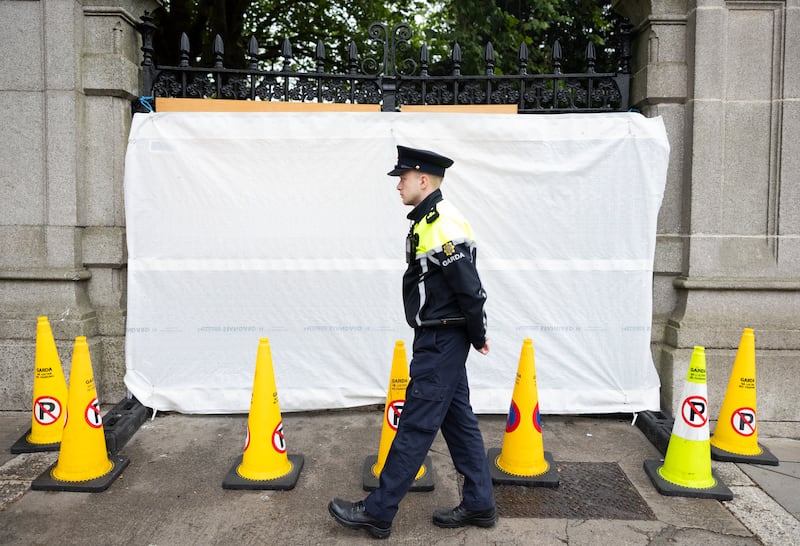In November 2010, a group of about 50 anti-austerity protesters stormed the gates of Government Buildings demanding the resignation of the taoiseach.
Inside the complex, there was widespread confusion among security personnel about what action should be taken. The protesters, who were mostly from Sinn Féin, were angry but did not seem to pose a lethal threat.
On the other hand, the soldiers and gardaí on hand had a duty to stop them from reaching Government Buildings and the office of Taoiseach.
If protesters had forced home their assault, the military police assigned to protection duty would have had to rely on their batons, and if that failed, on firing warning shots.
The next step would have been lethal force. “There was nothing else. We had no less-than-lethal equipment,” said one security source. Although they had sidearms, the soldiers lacked weapons which could stop an attack without inflicting potentially deadly wounds, such as bean bag rounds or Tasers.
The security personnel had been caught by surprise by the protest, as there had been no intelligence briefing that morning and there was general confusion as to who was responsible for taking the lead in repulsing the demonstrators.
Fourteen years later, not much has improved according to multiple security sources who spoke to The Irish Times. Security at Government Buildings and Leinster House “is a bit of a joke”, said one Defence Forces member.
This is despite multiple warnings about inadequate security from military personnel over the years, and several serious breaches of the complex.
A man was arrested earlier this month after the gates of Áras an Uachtaráin, the Office of the Attorney General and the Department of the Taoiseach were rammed with a van.
In 2014, a 19-year-old was detained on the Oireachtas campus while armed with a sword and several knives. He told gardaí he wanted to stage a “one-man rebellion”.
In 2021, a notorious far-right activist with a history of threatening to kill Government figures breached security to make his way on to the grounds of Leinster House before being arrested.
And in June last year, a teenager broke into Leinster House at night and defaced a copy of the 1916 Proclamation.
The general threat level faced by politicians has also increased, including bomb threats targeting the homes of the Taoiseach and Minister for Justice, and protests taking place regularly outside politicians’ homes.
One of the main issues raised by security personnel, including in formal letters to management, is a lack of co-ordination between the agencies responsible for protecting Leinster House and its environs.
Security is the responsibility of gardaí, a military police company and Leinster House ushers. However, there is no joint morning briefing on the day’s events or any forum for intelligence-sharing on threats.
There is also confusion over who has the authority to use deadly force on the campus. The Defence Forces’ use-of-force rules, which are laid out in a document called COD 6, do not permit armed soldiers to operate alongside armed gardaí. This is to avoid confusion over who has authority to use deadly force, and to avoid friendly fire incidents.
However, sources say this regulation is routinely ignored in Leinster House and Government Buildings, where armed detectives assigned to ministerial protection duty work alongside armed soldiers.
Military police have also complained in recent years that they are not provided with vital security information, including whether or not the Taoiseach is on the premises.
The military police guardroom is located close to the Office of the Taoiseach, and they are able to enter the office through a hidden door to escort the Taoiseach to a secure location if there is an emergency. However, in the past, there has been confusion over whether gardaí or military police are responsible for such evacuation.
Evacuation drills as well as drills for bomb threats or active shooters are not conducted with any regularity, as they “are considered alarmist”, one security source said.

The guardroom itself has also been a major bone of contention in recent years. Sources describe it as “Soviet-style” and not fit for purpose.
Several years ago, soldiers complained to management that Government staff were using the guardroom for yoga and circuit training at lunchtime.
“We have to buzz them in and sit there while they do their training. It’s awkward,” said a military source.
Concerns have also been raised about the strength of the gates around the complex, some of which were held in place only by the electronic mechanisms used to open and close them. It is understood some improvements have been made to the gates in recent years, but recommendations that an armed presence be maintained on the Kildare Street side of the complex have not been acted upon.
Military police have also raised concerns about their equipment. For years, soldiers assigned to the complex were issued only with handguns and were expected to wear their formal uniforms while on duty. Officers were not permitted to carry any weapons at all.
More recently, officers have started carrying sidearms and soldiers have started wearing camouflage fatigues.
Rifles have also been added to the armory but are not carried on duty. Although technically available in an emergency, they are lacking the modern sights featured on the Defence Forces’ standard Steyr rifle.
In response to queries, a spokeswoman for the Houses of the Oireachtas cited a long-standing policy of “not commenting on security matters”.

















